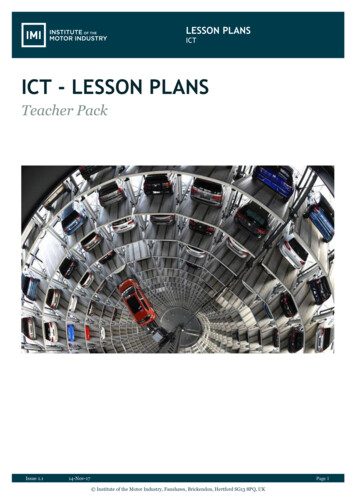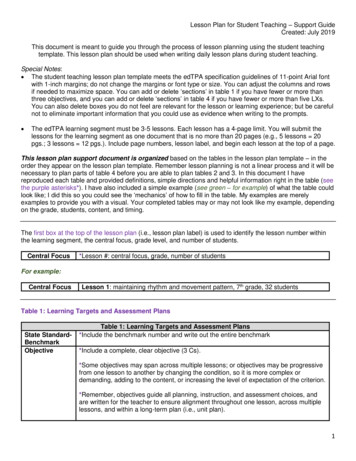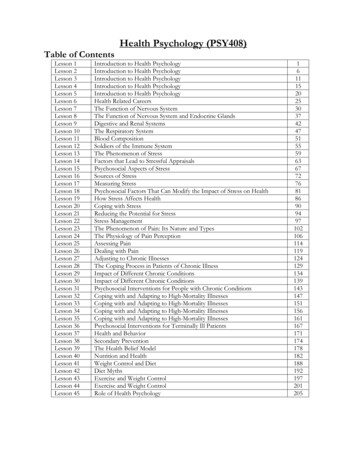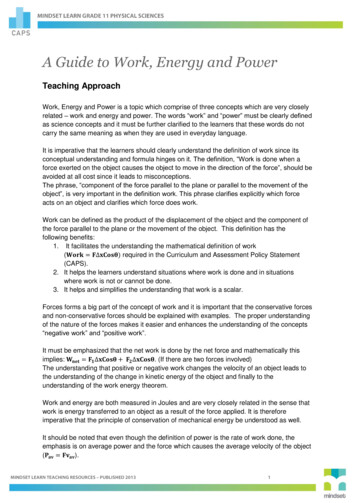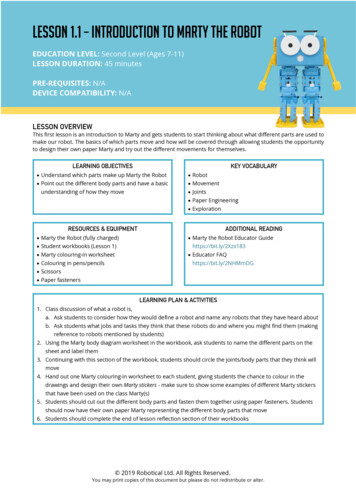
Transcription
Lesson 1.1 – introduction to marty the robotEDUCATION LEVEL: Second Level (Ages 7-11)LESSON DURATION: 45 minutesPRE-REQUISITES: N/ADEVICE COMPATIBILITY: N/ALESSON OVERVIEWThis first lesson is an introduction to Marty and gets students to start thinking about what different parts are used tomake our robot. The basics of which parts move and how will be covered through allowing students the opportunityto design their own paper Marty and try out the different movements for themselves.LEARNING OBJECTIVESKEY VOCABULARY Understand which parts make up Marty the Robot Robot Point out the different body parts and have a basic Movementunderstanding of how they move Joints Paper Engineering ExplorationRESOURCES & EQUIPMENTADDITIONAL READING Marty the Robot (fully charged) Marty the Robot Educator Guide Student workbooks (Lesson 1)https://bit.ly/2Xzx183 Marty colouring-in worksheet Educator FAQ Colouring in pens/pencilshttps://bit.ly/2NHMmDG Scissors Paper fastenersLEARNING PLAN & ACTIVITIES1. Class discussion of what a robot is,a. Ask students to consider how they would define a robot and name any robots that they have heard aboutb. Ask students what jobs and tasks they think that these robots do and where you might find them (makingreference to robots mentioned by students)2. Using the Marty body diagram worksheet in the workbook, ask students to name the different parts on thesheet and label them3. Continuing with this section of the workbook, students should circle the joints/body parts that they think willmove4. Hand out one Marty colouring-in worksheet to each student, giving students the chance to colour in thedrawings and design their own Marty stickers - make sure to show some examples of different Marty stickersthat have been used on the class Marty(s)5. Students should cut out the different body parts and fasten them together using paper fasteners. Studentsshould now have their own paper Marty representing the different body parts that move6. Students should complete the end of lesson reflection section of their workbooks 2019 Robotical Ltd. All Rights Reserved.You may print copies of this document but please do not redistribute or alter.
EXTENSIONS & CHALLENGES Student groups could continue their robot research some more and create presentations about a specificrobot and report back to the class (Literacy/Technologies)Curriculum BenchmarksCurriculum for Excellence – Technologies Benchmark Guide Fully Addresses Benchmark Partially Addresses BenchmarkCurriculum OrganiserBenchmark CoveredLesson 1.1Technological Developments inSociety and BusinessTCH 0-05a Craft, Design, Engineering andGraphicsComputing ScienceTCH 1-07aTCH 0-09aTCH 0-10aTCH 0-12aTCH 0-13aTCH 0-14aNational Curriculum – Computing, Design & Technology Fully Addresses Benchmark Partially Addresses BenchmarkCurriculum OrganiserBenchmark CoveredLesson 1.1Computing1-e 1.1-bDesign & Technology1.2-a1.3-aAustralian F-10 Curriculum – Digital Technologies, Design & Technologies Fully Addresses BenchmarkCurriculum Organiser Partially Addresses BenchmarkBenchmark CoveredLesson 1.1ACTDIK001 ACTDIK002Digital TDEK001Design & TechnologiesACTDEP006ACTDEP009 2019 Robotical Ltd. All Rights Reserved.You may print copies of this document but please do not redistribute or alter.
Lesson 1.2 – introduction to programmingEDUCATION LEVEL: Second Level (Ages 7-11)LESSON DURATION: 45 minutesPRE-REQUISITES: Lesson 1.1DEVICE COMPATIBILITY: Laptop, PC or TabletLESSON OVERVIEWNow that students have their own paper Marty prototype, we will start to build up on student’s understanding thatprogramming is simply a list of instructions. There will be an emphasis on trying to relate this back to real life to makeit more relatable. Students will start breaking down blocks of code to make sense of each individual instruction beforeputting together their own small programs.LEARNING OBJECTIVESKEY VOCABULARY Relate coding blocks and coding to real lifesituations Programming Paper prototyping Predict what outcomes different blocks of codewill have on the world Block coding Instructions/recipe Put together different blocks of code to achievecertain actions/outcomes Algorithm MovementRESOURCES & EQUIPMENTADDITIONAL READING Marty the Robot (fully charged) Marty the Robot Educator Guide Paper Marty (created from Lesson 1.1)https://bit.ly/2Xzx183 Student workbooks (Lesson 2) Educator FAQ Marty Says action cardshttps://bit.ly/2NHMmDG Access to compatible devices connected to Martyon Scratch Getting Started with Scratchhttps://bit.ly/2Vzc5xJLEARNING PLAN & ACTIVITIES1. Show a few different examples of Marty Says action cards that show different poses that Marty can make2. Students should then try to recreate these actions using their paper prototypes3. Get students to think about the steps that they took to recreate the pose using their paper Marty and writedown instructions for someone to repeat (relating back to the idea that programming is writing a list ofinstructions)4. Test these out using either paper Marty prototypes or by getting a student volunteer to pretend to be theclass robot5. Students should then move to their devices and, using the Scratch editor, start to put together differentblocks together to achieve the pose from the randomly selected Marty Says card6. Students should complete the end of lesson reflection section of their workbooksEXTENSIONS & CHALLENGES Try combining different poses to start putting together some dance moves for Marty (Technologies) Students should design and draw their own poses for Marty and challenge others in the class to program theirMarty to get into that position (Arts/Technologies) 2019 Robotical Ltd. All Rights Reserved.You may print copies of this document but please do not redistribute or alter.
Curriculum BenchmarksCurriculum for Excellence – Technologies Benchmark Guide Fully Addresses Benchmark Partially Addresses BenchmarkCurriculum OrganiserBenchmark CoveredLesson 1.2Digital LiteracyTCH 0-01aTechnological Developments inSociety and BusinessTCH 0-05a Craft, Design, Engineering andGraphicsTCH 3-05aTCH 0-11aTCH 1-11aTCH 0-12aTCH 0-13aTCH 1-13aTCH 0-14aComputing ScienceTCH 0-14bTCH 1-14aTCH 1-14bTCH 2-14aTCH 0-15aNational Curriculum – Computing, Design & Technology Fully Addresses BenchmarkCurriculum Organiser Partially Addresses BenchmarkBenchmark CoveredLesson 1.21-a 1-b1-cComputing1-e2-a2-c3-b1.1-aDesign & Technology1.1-b1.3-bAustralian F-10 Curriculum – Digital Technologies, Design & Technologies Fully Addresses BenchmarkCurriculum Organiser Partially Addresses BenchmarkBenchmark CoveredLesson 1.2ACTDIK001 ACTDIK002Digital TechnologiesACTDIP004ACTDIP010ACTDIP013 2019 Robotical Ltd. All Rights Reserved.You may print copies of this document but please do not redistribute or alter.
ACTDEK001Design & TechnologiesACTDEP005ACTDEP006ACTDEP009 2019 Robotical Ltd. All Rights Reserved.You may print copies of this document but please do not redistribute or alter.
Lesson 1.3 – getting comfortable with scratchEDUCATION LEVEL: Second Level (Ages 7-11)LESSON DURATION: 45 minutesPRE-REQUISITES: Lesson 1.1 & 1.2DEVICE COMPATIBILITY: Laptop, PC or TabletLESSON OVERVIEWStudents have now had their first taste of programming using the Scratch editor. In this lesson, they will begin tobecome more comfortable with the interface being used and start to build up an understanding of where certainblocks can be found. As part of this lesson, we will be introducing a little bit of debugging and trying to get studentsto recognise when something isn’t happening correctly and why we should frequently test our programs.LEARNING OBJECTIVESKEY VOCABULARY Relate coding blocks and coding to real lifesituations Programming Block coding Predict what outcomes different blocks of codewill have on the world Instructions/recipe Testing Recognise when the program has a bug or error Algorithm Understand why the error is happening and how Debuggingto fix itRESOURCES & EQUIPMENTADDITIONAL READING Marty the Robot (fully charged) Marty the Robot Educator Guide Student workbooks (Lesson 3)https://bit.ly/2Xzx183 Access to compatible devices connected to Marty Educator FAQon Scratchhttps://bit.ly/2NHMmDG Getting Started with Scratchhttps://bit.ly/2Vzc5xJLEARNING PLAN & ACTIVITIES1. Remind students of the last lesson where we introduced programming Marty using Scratch by showing someexamples of blocks on the screen and asking students what they think would happen2. Given a few examples, ask students to run a few small, pre-written, programs in Scratch and observe whetherthey do what they should be doinga. Encourage students to think about what the aim of the program is and how they would program Marty tomeet itb. Ask students to highlight what the small problems are with the program(s)3. Introduction to debugging and why it is important that we test our scripts with emphasis from real worldsituations and events4. Ask students to try and fix the problem with the program5. Repeat this exercise with a couple of different small programs where students debug and remix6. Students should complete the end of lesson reflection section of their workbooks 2019 Robotical Ltd. All Rights Reserved.You may print copies of this document but please do not redistribute or alter.
EXTENSIONS & CHALLENGES Encourage students to think about how they would improve these small programs and try to implement theideas themselves (Technologies) Research some of the different events and disasters highlighted in the lesson that could have beenprevented/minimised with some more testing and debugging (Literacy/Technologies)Curriculum BenchmarksCurriculum for Excellence – Technologies Benchmark Guide Fully Addresses BenchmarkCurriculum OrganiserDigital Literacy Partially Addresses BenchmarkBenchmark CoveredLesson 1.3TCH 0-01a TCH 1-01aTCH 2-01aTechnological Developments inSociety and BusinessCraft, Design, Engineering andGraphicsTCH 0-05aTCH 1-05aTCH 0-12aTCH 0-13a TCH 1-13aTCH 2-13aTCH 3-13aTCH 4-13bComputing ScienceTCH 0-14aTCH 0-14bTCH 1-14aTCH 1-14bTCH 0-15aTCH 1-15aTCH 2-15aNational Curriculum – Computing, Design & Technology Fully Addresses BenchmarkCurriculum Organiser Partially Addresses BenchmarkBenchmark CoveredLesson 1.31-a 1-b1-cComputing1-e2-a2-b3-aDesign & Technology1.1-b1.3-b 2019 Robotical Ltd. All Rights Reserved.You may print copies of this document but please do not redistribute or alter.
2.3-c Australian F-10 Curriculum – Digital Technologies, Design & Technologies Fully Addresses BenchmarkCurriculum Organiser Partially Addresses BenchmarkBenchmark CoveredLesson 1.3ACTDIK001 al TDIP020ACTDIP027ACTDIP029ACTDEK001Design & TechnologiesACTDEK004ACTDEP006ACTDEP009 2019 Robotical Ltd. All Rights Reserved.You may print copies of this document but please do not redistribute or alter.
Lesson 1.4 – marty dance partyEDUCATION LEVEL: Second Level (Ages 7-11)LESSON DURATION: 45 minutesPRE-REQUISITES: Lesson 1.1, 1.2 & 1.3DEVICE COMPATIBILITY: Laptop, PC or TabletLESSON OVERVIEWIn this lesson, we follow on from the first three lessons where students have started to explore not only programmingbut also what we can program Marty to do. We will continue to explore the different functionalities and features ofMarty by programming Marty to dance, challenging students to have a Marty dance-off!LEARNING OBJECTIVESKEY VOCABULARY Build upon knowledge of movements andfunctionalities that Marty has Robot Movement Develop a Scratch program to program Marty todance Joints Programming Start to think about joining different movementstogether Dancing AlgorithmRESOURCES & EQUIPMENTADDITIONAL READING Marty the Robot (fully charged) Marty the Robot Educator Guide Student workbooks (Lesson 4)https://bit.ly/2Xzx183 Access to compatible devices connected to Martyon Scratch Educator FAQhttps://bit.ly/2NHMmDG Marty Says action cards Getting Started with Scratchhttps://bit.ly/2Vzc5xJLEARNING PLAN & ACTIVITIES1. Recap what has been done in previous lessons, including looking at different moves that Marty can do byshowing a couple of the Marty Says action cards and touch on the importance of testing code frequently2. Students break into small groups (2-4) and begin to plan out their dance before moving on to their devices toprogram Marty together3. Student groups take turns to demo the dance moves that they have programmed4. Students can then go back to development to add new things to their routine or improve current moves afterclass demonstrations5. Students should complete the end of lesson reflection section of their workbooksEXTENSIONS & CHALLENGES Ask students to think about a popular dance move that they know and see if they can program Marty to dothese moves (Arts/Technologies) Get students to pick a song to create a dance to, so that they can try to develop moves that work in time withthe song (Arts/Technologies) Create a stage, pick a song and film the dance routine that can be edited by students and turned into their ownmusic video (Arts/Technologies) 2019 Robotical Ltd. All Rights Reserved.You may print copies of this document but please do not redistribute or alter.
Curriculum BenchmarksCurriculum for Excellence – Technologies Benchmark Guide Fully Addresses Benchmark Partially Addresses BenchmarkCurriculum OrganiserBenchmark CoveredLesson 1.4Digital LiteracyTCH 0-01a TCH 1-01aTechnological Developments inSociety and BusinessTCH 0-05aCraft, Design, Engineering andGraphicsTCH 0-11a TCH 0-13a TCH 1-13aTCH 2-13aTCH 3-13bTCH 0-14aComputing ScienceTCH 0-14bTCH 1-14aTCH 2-14aTCH 0-15aTCH 1-15aTCH 2-15aNational Curriculum – Computing, Design & Technology Fully Addresses BenchmarkCurriculum Organiser Partially Addresses BenchmarkBenchmark CoveredLesson 1.41-a 1-b1-cComputing2-a2-b2-c3-aDesign & Technology1.1-a1.3-bAustralian F-10 Curriculum – Digital Technologies, Design & Technologies Fully Addresses BenchmarkCurriculum OrganiserDigital Technologies Partially Addresses BenchmarkBenchmark CoveredLesson 1.4ACTDIK001 ACTDIK002ACTDIP003ACTDIP004 2019 Robotical Ltd. All Rights Reserved.You may print copies of this document but please do not redistribute or alter.
CTDIP030ACTDIP031ACTDIP039ACTDEK001ACTDEK002Design & TechnologiesACTDEK004ACTDEP005ACTDEP006ACTDEP009 2019 Robotical Ltd. All Rights Reserved.You may print copies of this document but please do not redistribute or alter.
Lesson 1.4 - marty dance party EDUCATION LEVEL: Second Level (Ages 7-11) LESSON DURATION: 45 minutes PRE-REQUISITES: Lesson 1.1, 1.2 & 1.3 DEVICE COMPATIBILITY: Laptop, PC or Tablet LESSON OVERVIEW In this lesson, we follow on from the first three lessons where students have started to explore not only programming








